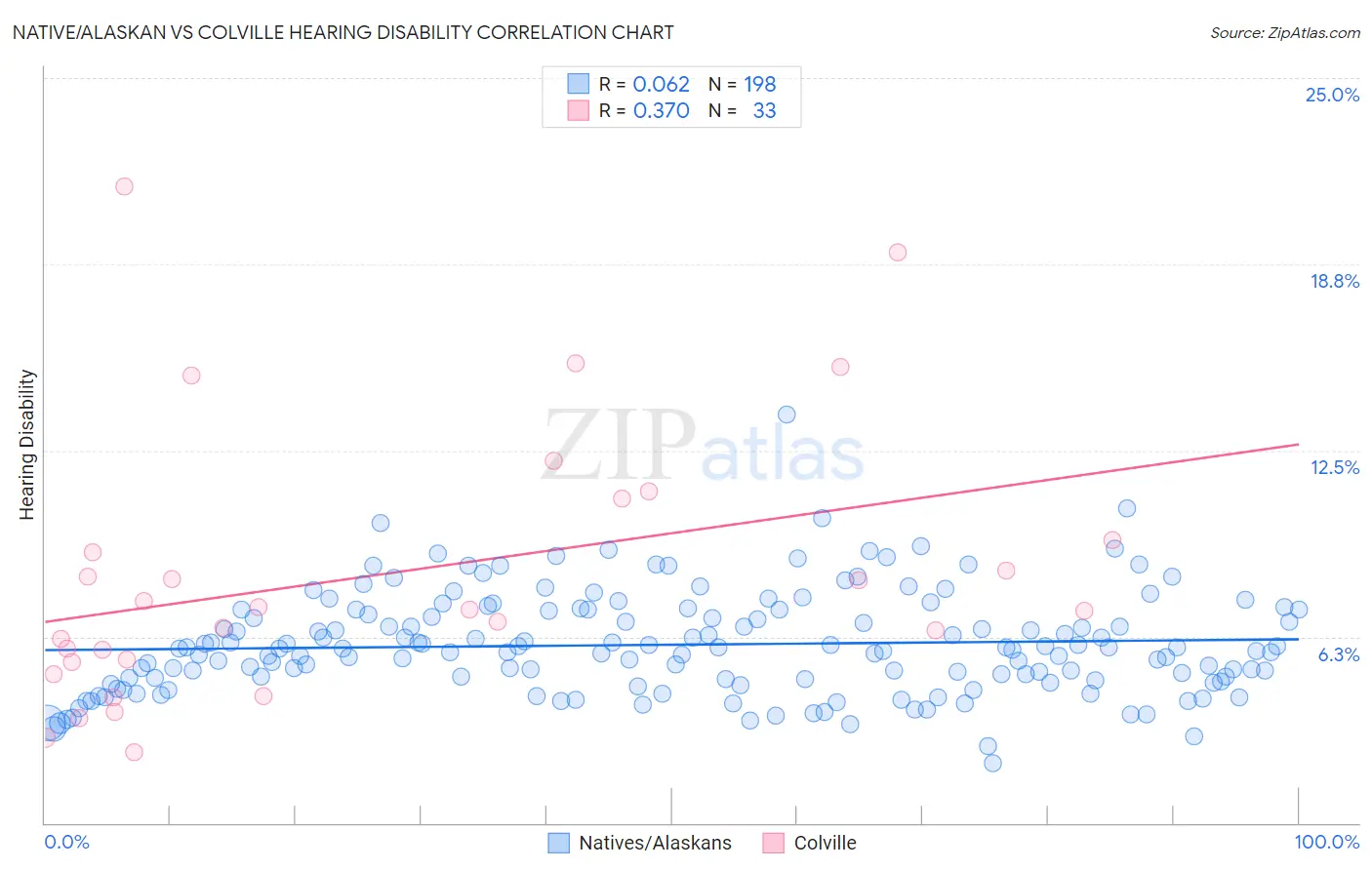Native/Alaskan vs Colville Hearing Disability
COMPARE
Native/Alaskan
Colville
Hearing Disability
Hearing Disability Comparison
Natives/Alaskans
Colville
4.2%
HEARING DISABILITY
0.0/ 100
METRIC RATING
330th/ 347
METRIC RANK
5.3%
HEARING DISABILITY
0.0/ 100
METRIC RATING
346th/ 347
METRIC RANK
Native/Alaskan vs Colville Hearing Disability Correlation Chart
The statistical analysis conducted on geographies consisting of 512,663,343 people shows a slight positive correlation between the proportion of Natives/Alaskans and percentage of population with hearing disability in the United States with a correlation coefficient (R) of 0.062 and weighted average of 4.2%. Similarly, the statistical analysis conducted on geographies consisting of 34,687,289 people shows a mild positive correlation between the proportion of Colville and percentage of population with hearing disability in the United States with a correlation coefficient (R) of 0.370 and weighted average of 5.3%, a difference of 27.4%.

Hearing Disability Correlation Summary
| Measurement | Native/Alaskan | Colville |
| Minimum | 2.0% | 2.4% |
| Maximum | 13.7% | 21.4% |
| Range | 11.7% | 19.0% |
| Mean | 6.0% | 8.3% |
| Median | 5.9% | 7.2% |
| Interquartile 25% (IQ1) | 4.8% | 5.5% |
| Interquartile 75% (IQ3) | 7.2% | 10.2% |
| Interquartile Range (IQR) | 2.3% | 4.7% |
| Standard Deviation (Sample) | 1.7% | 4.6% |
| Standard Deviation (Population) | 1.7% | 4.5% |
Demographics Similar to Natives/Alaskans and Colville by Hearing Disability
In terms of hearing disability, the demographic groups most similar to Natives/Alaskans are Cherokee (4.2%, a difference of 0.15%), Crow (4.2%, a difference of 0.79%), Tohono O'odham (4.2%, a difference of 0.80%), Houma (4.2%, a difference of 0.83%), and Dutch West Indian (4.3%, a difference of 1.4%). Similarly, the demographic groups most similar to Colville are Alaskan Athabascan (5.3%, a difference of 0.43%), Yup'ik (5.8%, a difference of 9.3%), Tlingit-Haida (4.8%, a difference of 10.4%), Inupiat (4.7%, a difference of 13.4%), and Tsimshian (4.7%, a difference of 13.7%).
| Demographics | Rating | Rank | Hearing Disability |
| Tohono O'odham | 0.0 /100 | #328 | Tragic 4.2% |
| Crow | 0.0 /100 | #329 | Tragic 4.2% |
| Natives/Alaskans | 0.0 /100 | #330 | Tragic 4.2% |
| Cherokee | 0.0 /100 | #331 | Tragic 4.2% |
| Houma | 0.0 /100 | #332 | Tragic 4.2% |
| Dutch West Indians | 0.0 /100 | #333 | Tragic 4.3% |
| Aleuts | 0.0 /100 | #334 | Tragic 4.3% |
| Kiowa | 0.0 /100 | #335 | Tragic 4.3% |
| Creek | 0.0 /100 | #336 | Tragic 4.4% |
| Chickasaw | 0.0 /100 | #337 | Tragic 4.5% |
| Alaska Natives | 0.0 /100 | #338 | Tragic 4.5% |
| Choctaw | 0.0 /100 | #339 | Tragic 4.5% |
| Pueblo | 0.0 /100 | #340 | Tragic 4.6% |
| Navajo | 0.0 /100 | #341 | Tragic 4.6% |
| Tsimshian | 0.0 /100 | #342 | Tragic 4.7% |
| Inupiat | 0.0 /100 | #343 | Tragic 4.7% |
| Tlingit-Haida | 0.0 /100 | #344 | Tragic 4.8% |
| Alaskan Athabascans | 0.0 /100 | #345 | Tragic 5.3% |
| Colville | 0.0 /100 | #346 | Tragic 5.3% |
| Yup'ik | 0.0 /100 | #347 | Tragic 5.8% |